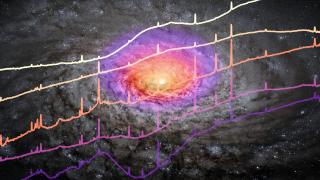Bibcode
del Moral-Castro, I.; García-Lorenzo, B.; Ramos Almeida, C.; Ruiz-Lara, T.; Falcón-Barroso, J.; Sánchez, S. F.; Sánchez-Blázquez, P.; Márquez, I.; Masegosa, J.
Referencia bibliográfica
Astronomy and Astrophysics
Fecha de publicación:
7
2020
Revista
Número de citas
11
Número de citas referidas
11
Descripción
We present a comparison of the spin parameter λR, measured in a region dominated by the galaxy disc, between 20 pairs of nearby (0.005 < z < 0.03) seemingly isolated twin galaxies differing in nuclear activity. We find that 80-82% of the active galaxies show higher values of λR than their corresponding non-active twin(s), indicating larger rotational support in the active galactic nuclei (AGN) discs. This result is driven by the 11 pairs of unbarred galaxies, for which 100% of the AGN show larger λR than their twins. These results can be explained by a more efficient angular momentum transfer from the inflowing gas to the disc baryonic matter in the case of the active galaxies. This gas inflow could have been induced by disc or bar instabilities, although we cannot rule out minor mergers if these are prevalent in our active galaxies. This result represents the first evidence of galaxy-scale differences between the dynamics of active and non-active isolated spiral galaxies of intermediate stellar masses (1010 < M* < 1011 M☉) in the Universe.
Proyectos relacionados

Huellas de la Formación de las Galaxias: Poblaciones estelares, Dinámica y Morfología
Bienvenida a la página web del g rupo de investigación Traces of Galaxy Formation. Somos un grupo de investigación amplio, diverso y muy activo cuyo objetivo principal es entender la formación de galaxias en el Universo de una manera lo más completa posible. Con el estudio detellado de las poblaciones estelares como bandera, estamos constantemente
Anna
Ferré Mateu

Actividad Nuclear en Galaxias: una Perspectiva 3D del Núcleo y su Entorno
Nuestro proyecto puede dividirse en dos líneas principales de investigación. En primer lugar, el estudio de los vientos producidos por cuásares luminosos oscurecidos y del impacto que estos tienen en sus galaxias anfitrionas (retroalimentación del AGN). Para ello hemos obtenido observaciones en el óptico e infrarrojo cercano con el Gran Telescopio
Cristina
Ramos Almeida